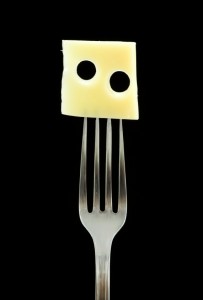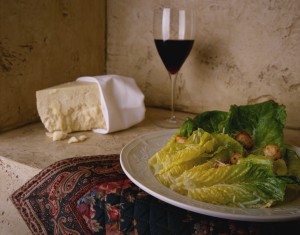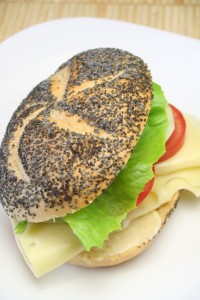 Lighten Up!
Lighten Up!
Have you resolved to lose a few pounds this year? Or just eat “healthier?” If so, you might want to visit the growing world of lower-fat cheese. There are a lot to try and many come in convenient sliced, shredded and snack stick forms.
Given the immense popularity of cheese among Americans (especially cheddar-type cheeses which comprise about 90% of consumption) and our need to “get in shape,” it’s no surprise cheese makers are trimming fat and calories from this favorite food. Two-thirds of adults are overweight or obese and children and teens are growing in girth along with adults. The Dietary Guidelines 2010 tell us to cut back on “solid fats,” balance our calories to reach or maintain a healthy weight , increase the nutrient density of our diets and get more dairy foods (or substitutes).
Lower-fat cheese can help meet these dietary needs, delivering most of the nutrients in milk in a convenient form. When you pull fat from cheese, you still have lots of high-quality protein and calcium, a key nutrient many of us are lacking. Protein is a hot topic. One notion that keeps coming up in weight-loss research is the value of protein to enhance satiety, satisfaction and therefore dietary compliance. Higher protein weight loss diets also seem to preserve muscle mass and encourage fat loss in dieters. In diabetic meal planning and school food service meals cheese is considered a meat substitute, ounce for ounce, because it is so protein- and nutrient-rich.
Is there a role for lower-fat cheese in your diet?  Here’s how they fit into mine: I love regular, full-flavored artisan cheeses, locally made and from around the world. These I tend to save for a week-end cheese platter, special recipes and entertaining. When it comes to a quick lunch or afternoon snack I reach for one of my favorite reduced-fat cheeses. And why be a snob? Someone committed to shedding pounds may find these products fill a cheese craving without breaking their budget for fat and calories.
Here’s how they fit into mine: I love regular, full-flavored artisan cheeses, locally made and from around the world. These I tend to save for a week-end cheese platter, special recipes and entertaining. When it comes to a quick lunch or afternoon snack I reach for one of my favorite reduced-fat cheeses. And why be a snob? Someone committed to shedding pounds may find these products fill a cheese craving without breaking their budget for fat and calories.
Tips to Enjoy Lower-Fat Cheese
Keep an Open Mind Rather than comparing lower-fat cheeses with full-fat counterparts, consider lower-fat cheese a category of its own – with unique purposes. They are not all good (as I discovered when I conducted a tasting of 10 modified cheeses for a group of dairy experts) so taste various brands and types for ones you like.
Read the Label Lighter cheese can be very confusing. Mozzarella comes in whole milk, reduced-fat, part-skim, lite and fat-free versions – and some may be low moisture. The front label will generally tell the fat and calories you save compared to the brand’s regular product or a similar one. Check the nutrition facts panel for details – different brands of the same type of cheese, such as cheddar, have different nutrient contents. While a 25% or 30% fat or calorie saving may not sound like much, if you consume cheese regularly these small changes may be significant.
Use them Correctly and Manage Your Expectations Reduced-fat varieties melt more like full-fat cheese than low-fat (3 grams of fat or less per serving by law) or fat-free versions which may soften but not melt. That’s because fat is integral to the flavor, texture and heating properties of cheese.  Fat-free and low-fat cheese is best left uncooked and layered in a sandwich or sprinkled on a salad or taco where you won’t notice the different taste and texture but will appreciate the protein and calcium.
Fat-free and low-fat cheese is best left uncooked and layered in a sandwich or sprinkled on a salad or taco where you won’t notice the different taste and texture but will appreciate the protein and calcium.
Cooking with Reduced-Fat Cheese Heat gently as they don’t melt quite like full-fat cheese. In a microwave, heat cheeses at 50% power. Try them in fillings for omelets, quesadillas, enchiladas or casseroles mixed with other ingredients. I layered sliced, reduced-fat mozzarella, into a lightened eggplant parmesan with our rich-tasting homemade tomato sauce and it was fine. Be aware that some fat-free cheese is actually “pasteurized processed,” not natural cheese, which I avoid.
What about Sodium? You can find some lower-sodium cheeses as well as sodium- and fat-reduced cheese. Salt is essential to the process of making natural cheese so it can’t be eliminated completely, and salt substitutes have not proven acceptable. (Potassium chloride leaves a bitter aftertaste.) Some cheeses are naturally low in sodium, such as Swiss types (as low as 50 mg per serving), and some are naturally higher, such as blue cheese (about 400 mg/serving). Unfortunately, some cheese makers increase the sodium when the decrease the fat in cheese, presumably to boost flavor. Others seem to add seasonings such as jalapeno to boost the flavor – a better idea.
Worth A Try ![Cheese 1]](https://lorelledelmatto.com/wp-content/uploads/2012/01/MP9003878581-214x300.jpg) I can’t say I’ve tried all the reduced-fat cheeses – there are too many out there – but these are a few I like: Jarlsberg Lite; Kerrygold Reduced-Fat, Trader Joe’s Light Sharp Celtic, Reduced-Fat Gouda and Reduced-Fat Feta; Finlandia brand light cheeses (various flavors); Safeway brand sliced provolone, Tillamook Reduced-Fat Medium Cheddar, Cabot Reduced Fat Cheddars. Sargento has an impressive selection of sliced reduced-fat and reduced-sodium cheeses but I have not seen many in my local markets.
I can’t say I’ve tried all the reduced-fat cheeses – there are too many out there – but these are a few I like: Jarlsberg Lite; Kerrygold Reduced-Fat, Trader Joe’s Light Sharp Celtic, Reduced-Fat Gouda and Reduced-Fat Feta; Finlandia brand light cheeses (various flavors); Safeway brand sliced provolone, Tillamook Reduced-Fat Medium Cheddar, Cabot Reduced Fat Cheddars. Sargento has an impressive selection of sliced reduced-fat and reduced-sodium cheeses but I have not seen many in my local markets.
I expect this list ofcheese to grow. Any suggestions?
Copyright © Lorelle S. Del Matto 2012
 About lorelle
About lorelle
Love the nutrition information and especially your suggestions for low fat cheeses that you particularly enjoy.